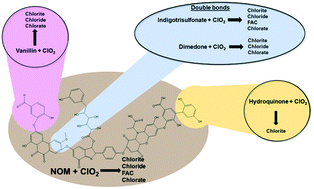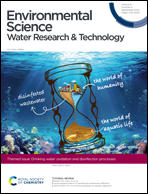Reaction of chlorine dioxide with organic matter – formation of inorganic products†
Abstract
Chlorine dioxide (ClO2) is used for disinfection of water and pollutant control. Recently it was shown that free available chlorine (FAC) is formed during the oxidation of organic compounds with ClO2. To investigate the moieties in natural organic matter (NOM) responsible for the FAC formation, reactions of ClO2 with phenols and olefins were investigated. Thereby primary yields of the inorganic by-products chlorite, chloride, FAC, and chlorate were determined and compared with Suwannee River natural organic matter (SRNOM). The reaction of ClO2 with the studied model compounds (vanillin, hydroquinone, indigotrisulfonate, and dimedone) revealed very different inorganic by-products. The main inorganic by-product of all investigated compounds was chlorite (>50% per consumed ClO2). Besides chlorite, vanillin formed 35% chloride and 4% chlorate, indigotrisulfonate 25% chloride, 7% FAC and 3% chlorate and dimedone 50% chloride and 4% chlorate. Hydroquinone formed exclusively chlorite (90%). Yields of FAC formed by ClO2 oxidation of SRNOM were significant (22%), which principally could result in halogenated organic by-products. Additionally, chlorite (63%), chloride (8%) and chlorate (5%) were formed. The yield of FAC decreased significantly after pre-ozonation, which can be explained by ozone induced formation of poly-hydroxylated aromatic compounds, which may mainly form chlorite in analogy to hydroquinone.

- This article is part of the themed collection: Drinking water oxidation and disinfection processes


 Please wait while we load your content...
Please wait while we load your content...